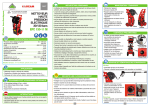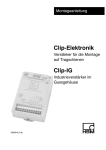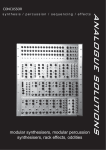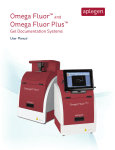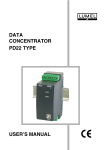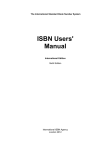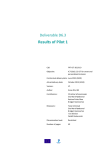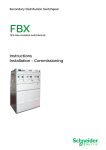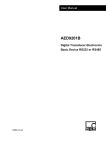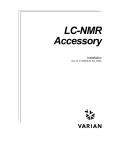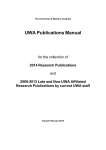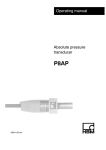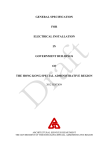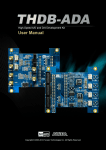Download Operating Manual
Transcript
Operating Manual Amplifier System MGA II with Digital Display DA12 B0599-3.7 en HBM 3 Contents A B Safety instructions . . . . . . . . . . . . . . . . . . . . . . . . . . . . . . . . . . . . . . . . . . . . . . . . . . . . . . . . . . . . . . 5 Introduction . . . . . . . . . . . . . . . . . . . . . . . . . . . . . . . . . . . . . . . . . . . . . . . . . . . . . . . . . . . . . . . . . . . . . A−1 1 Notes on documentation . . . . . . . . . . . . . . . . . . . . . . . . . . . . . . . . . . . . . . . . . . . . . . . . . . . . . A−2 2 MGA II housings . . . . . . . . . . . . . . . . . . . . . . . . . . . . . . . . . . . . . . . . . . . . . . . . . . . . . . . . . . . . . A−4 3 Structure of the MGA II device . . . . . . . . . . . . . . . . . . . . . . . . . . . . . . . . . . . . . . . . . . . . . . . . A−7 3.1 Control elements for the digital indicator . . . . . . . . . . . . . . . . . . . . . . . . . . . . . . . . . . . . . A−9 3.2 Control elements for the amplifier plug−in units . . . . . . . . . . . . . . . . . . . . . . . . . . . . . . . A−10 3.3 Component location diagrams, connection boards . . . . . . . . . . . . . . . . . . . . . . . . . . . . A−11 3.4 Component location diagrams ME10, ME30, ME50, ME50S6 . . . . . . . . . . . . . . . . . . A−14 4 Conditions on site . . . . . . . . . . . . . . . . . . . . . . . . . . . . . . . . . . . . . . . . . . . . . . . . . . . . . . . . . . . A−15 5 Maintenance and cleaning . . . . . . . . . . . . . . . . . . . . . . . . . . . . . . . . . . . . . . . . . . . . . . . . . . . . A−16 Connections . . . . . . . . . . . . . . . . . . . . . . . . . . . . . . . . . . . . . . . . . . . . . . . . . . . . . . . . . . . . . . . . . . . . B−1 1 Mains connection . . . . . . . . . . . . . . . . . . . . . . . . . . . . . . . . . . . . . . . . . . . . . . . . . . . . . . . . . . . . B−2 1.1 Shielding design . . . . . . . . . . . . . . . . . . . . . . . . . . . . . . . . . . . . . . . . . . . . . . . . . . . . . . . . . B−3 Connecting transducers . . . . . . . . . . . . . . . . . . . . . . . . . . . . . . . . . . . . . . . . . . . . . . . . . . . . . . B−4 2.1 Connect strain−gage full bridge . . . . . . . . . . . . . . . . . . . . . . . . . . . . . . . . . . . . . . . . . . . . B−5 2.2 Connect inductive half bridge . . . . . . . . . . . . . . . . . . . . . . . . . . . . . . . . . . . . . . . . . . . . . . B−6 2.3 Intrinsically safe transducer port . . . . . . . . . . . . . . . . . . . . . . . . . . . . . . . . . . . . . . . . . . . . B−7 2.3.1 Electrical connection to AP05 . . . . . . . . . . . . . . . . . . . . . . . . . . . . . . . . . . . . . . . . B−8 Outputs and remotes . . . . . . . . . . . . . . . . . . . . . . . . . . . . . . . . . . . . . . . . . . . . . . . . . . . . . . . . . B−10 3.1 Connection boards AP01, AP03, AP05, AP11 . . . . . . . . . . . . . . . . . . . . . . . . . . . . . . . . B−10 Synchronisation (ME30 and ME50 only) . . . . . . . . . . . . . . . . . . . . . . . . . . . . . . . . . . . . . . . B−12 Commissioning . . . . . . . . . . . . . . . . . . . . . . . . . . . . . . . . . . . . . . . . . . . . . . . . . . . . . . . . . . . . . . . . . C−1 1 Commissioning . . . . . . . . . . . . . . . . . . . . . . . . . . . . . . . . . . . . . . . . . . . . . . . . . . . . . . . . . . . . . . C−2 1.1 Devices in the desktop housing and module frame . . . . . . . . . . . . . . . . . . . . . . . . . . . C−3 2 3 4 C 1.2 Switching on . . . . . . . . . . . . . . . . . . . . . . . . . . . . . . . . . . . . . . . . . . . . . . . . . . . . . . . . . . . . . C−4 MGA II 4 D E Balancing/Range . . . . . . . . . . . . . . . . . . . . . . . . . . . . . . . . . . . . . . . . . . . . . . . . . . . . . . . . . . . . . . . . D−1 1 Balancing . . . . . . . . . . . . . . . . . . . . . . . . . . . . . . . . . . . . . . . . . . . . . . . . . . . . . . . . . . . . . . . . . . . D−2 1.1 Excitation voltage . . . . . . . . . . . . . . . . . . . . . . . . . . . . . . . . . . . . . . . . . . . . . . . . . . . . . . . . D−2 1.2 Zero balancing . . . . . . . . . . . . . . . . . . . . . . . . . . . . . . . . . . . . . . . . . . . . . . . . . . . . . . . . . . . D−4 2 Setting a range . . . . . . . . . . . . . . . . . . . . . . . . . . . . . . . . . . . . . . . . . . . . . . . . . . . . . . . . . . . . . . D−5 3 Calibrating the measuring chain . . . . . . . . . . . . . . . . . . . . . . . . . . . . . . . . . . . . . . . . . . . . . . D−9 4 Zero operating mode . . . . . . . . . . . . . . . . . . . . . . . . . . . . . . . . . . . . . . . . . . . . . . . . . . . . . . . . . D−11 5 Measurement frequency range /Cut−off frequency . . . . . . . . . . . . . . . . . . . . . . . . . . . . . D−12 Index . . . . . . . . . . . . . . . . . . . . . . . . . . . . . . . . . . . . . . . . . . . . . . . . . . . . . . . . . . . . . . . . . . . . . . . . . . . E−1 MGA II 5 Safety instructions Use in accordance with the regulations The amplifier system is to be used exclusively for measurement tasks and directly related control tasks. Use for any purpose other than the above shall be deemed to be not in accordance with the regulations. To ensure safe operation, the device may only be operated in accordance with the information given in the User Manual. It is also essential to comply with the legal and safety requirements for the application concerned during use. The same applies to the use of accessories. General dangers of failing to follow the safety instructions The amplifier system is a state−of−the−art device and is safe to operate. The device may give rise to further dangers if it is inappropriately installed and operated by untrained personnel. Any person instructed to carry out installation, commissioning, maintenance or repair of the device must have read and understood the User Manual and in particular the technical safety instructions. Residual dangers The scope of supply and list of components provided with the amplifier system cover only part of the scope of measurement technology. In addition, equipment planners, installers and operators should plan, implement and respond to the safety engineering considerations of measurement technology in such a way as to minimise residual dangers. Prevailing regulations must be complied with at all times. There must be reference to the residual dangers connected with measurement technology. After setting up and password protected activities, care must be taken to ensure that any control units that may be connected remain in a safe and secure state until the switching behaviour of the amplifier system has been checked. MGA II 6 Warnzeichen und Gefahrensymbole Wichtige Hinweise für Ihre Sicherheit sind besonders gekennzeichnet. Beachten Sie diese Hinweise unbedingt, um Unfälle und Sachschäden zu vermeiden. Sicherheitshinweise sind wie folgt aufgebaut: SIGNALWORT Art der Gefahr Folgen bei Nichtbeachtung Gefahrenabwehr Warnzeichen: Signalwort: Art der Gefahr: Folgen: Abwehr: MGA II macht auf die Gefahr aufmerksam gibt die Schwere der Gefahr an (siehe folgende Tabelle) benennt die Art oder Quelle der Gefahr beschreibt die Folgen bei Nichtbeachtung gibt an, wie man die Gefahr vermeidet/umgeht 7 Gefahrenklassen nach ANSI Warnzeichen, Signalwort Bedeutung kennzeichnet eine gefährliche Situation, in der Tod oder schwere Körperverletzung eintreten können, wenn sie nicht vermieden wird VORSICHT HINWEIS kennzeichnet eine gefährliche Situation, in der leichte bis mittelschwere Körperverletzungen eintreten können, wenn sie nicht vermieden wird. Sachschäden: Das Produkt oder die Umgebung können beschädigt werden. Auf dem Modul Bedeutung: Angaben in der Bedienungsanleitung berücksichtigen MGA II 8 Information about CE labelling The devices in the MGA II range carry the CE label and satisfy the requirements of EU guideline 2004/108/EG “Elektromagnetic compatibility” and of the Low Voltage Directive 2006/95/EC admits listed harmonised European standards (EN). The EU declarations of conformity according to the above mentioned EU guideline , Article 10, for the relevant authorities are available from: HOTTINGER BALDWIN MESSTECHNIK GMBH Im Tiefen See 45 D−64239 Darmstadt The MGA II system devices are designed for industrial and domestic applications (domestic area, business and trade, small scale enterprises) and fulfil the requirements for interference immunity and for emisssion according to EN61326−1: 2006. In addition to the details given in the operating instructions, the following information should be taken into account when operating the device: The connecting cable must be screened and the screen must be connected flat on the connector housing. If system components (e.g. plug-in cards) are supplied separately, then the operator must ensure that they are used in a HBM system housing or in an equivalent housing. MGA II 9 Working safely Error messages should only be acknowledged if the cause of the error is removed and no further danger exists. The instrument complies with the safety requirements of DIN EN 61010, Part 1 (VDE 0411, Part 1); Protection Class I. To ensure adequate immunity from interference, use only Greenline shielded ducting (see HBM offprint ”Greenline shielding design, EMC-compliant measuring cable; downloadable from the Internet at http://www.hbm.com/Greenline). Conversions and modifications The measuring amplifier system must not be modified from the design or safety engineering point of view except with our express agreement. Any modification shall exclude all liability on our part for any damage resulting therefrom. In particular, any repair or soldering work on motherboards is prohibited. When exchanging any modules, only original HBM parts must be used. Qualified personnel means persons entrusted with the installation, assembly, commissioning and operation of the product who possess the appropriate qualifications for their function. This instrument is only to be installed and used by qualified personnel strictly in accordance with the technical data and with the safety rules and regulations which follow. It is also essential to comply with the appropriate legal and safety regulations for the application concerned during use. The same applies to the use of accessories. Maintenance and repair work on an open device with the power on must only be carried out by trained personnel who are aware of the dangers involved. MGA II 10 Safety requirements Before commissioning, find out whether the mains voltage and current type specified on the identification plate match the mains voltage and current type at the place of use, and whether the circuit being used is adequately protected. Insert the mains plug only into a socket with a protection switch (Protection Class I). When connecting electrical devices to low voltage: connect to extra−low safety voltage only (safety transformer in accordance with DINVDE 0551/ EN60742). Before you open the device, make sure it is switched off; remove the mains plug from the socket. Never pull the mains plug from the socket by the mains cable. Automation equipment and devices must be covered over in such a way that adequate protection or locking against unintentional actuation is provided (such as access checks, password protection, etc.). The MGAII must be positioned such that the mains connection can be accessed and the device disconnected from the mains at any time. Do not operate the device, if the mains cable is damaged. If an amplifier channel is to be withdrawn, close off the plug−in unit with a blanking plate. Built−in devices must only ever be operated whilst they are within the housing provided for them. The device complies with the safety requirements of DIN EN 61010-Part 1 (VDE 0411-Part 1); Protection Class I. MGA II Introduction Ý Notes on documentation A A−1 Introduction MGA II A−2 1 Introduction Ý Notes on documentation Notes on documentation This Manual contains all the information you need to operate the MGA II. There are several guidelines available to you: • Each Section starts with a list of its contents. • The header tells you which Section or sub−section you are currently reading. Example: Connections Ý Transducer B-15 • The page numbering is linked to capital letters which correspond to the Section headings. Symbols used in this manual: Symbol: Meaning: CE mark The CE mark enables the manufacturer to guarantee that the product complies with the requirements of the relevant EC guidelines (the Declaration of Conformity can be found at http://www.hbm.com/HBMdoc). MGA II Introduction Ý Notes on documentation A−3 Symbol: Meaning: Statutory marking requirements for waste disposal National and local regulations regarding the protection of the environment and recycling of raw materials require old equipment to be separated from regular domestic waste for disposal. For more detailed information on disposal, please contact the local authorities or the dealer from whom you purchased the product. IMPORTANT Important information Indicates important information about the product or about handling the product. TIP Information / Instructions for use Instructions for use or other valuable information for the user. MGA II A−4 Introduction Ý MGA II housings 2 MGA II housings The MGA II System is supplied in various housings: Desktop housing TG 007 (458x171x367) Desktop housing TG 005 (255x171x367) Desktop housing TG011 (173x171x367) 19” module frame ER 007 (483x132.5x367) (W x H x D in mm) Desktop housing TG005 TG007 TG011 − MGA II Module frame − − − ER007 Maximum number of channels 6 12 2 12 Supply voltage 230 V (115 V) 230 V (115 V) 230 V (115 V) 230 V (115 V) Introduction Ý MGA II housings A−5 All basic versions of the device consist of the following components: • • • • • Housing DA12 digital indicators (indication limit 19.999) Amplifier plug−in units (ME10 ....) Connection boards (AP01, AP03 ... ) Power pack Accessories • Kab133A adapter cable; 0.3 m, (D-connector to MS coupler socket) • Kab251-05 synchronisation cable; 0.5 m, (2x 5−pin cable plugs) • DB−25P connecting plug (25−pin cable plug with housing and fixing accessories for output and control signals) • DB−15P connecting plug (15−pin cable plug with housing and fixing accessories for transducer port) • D25-BNC/2 connecting plug; with BNC jack • EM001 end−phase module, switchable to impressed voltage or impressed current; can be plugged on to connection boards MGA II A−6 Introduction Ý MGA II housings Protection class The degree of protection given in the technical data indicates the suitability of the housings for various ambient conditions and also the protection of persons against potential risks when used. The letters IP (International Protection), which are always present in the designation, are followed by two digits. These indicate which degree of protection a housing offers against contact or foreign bodies (first digit) and moisture (second digit). The MGA II System is available in housings with degree of protection IP20 (as per DIN EN 60529). IP Code index 2 Degree of protection against 0 Code index Degree of protection against water contact and foreign bodies MGA II 2 Protection against contact with fingers, protection against foreign bodies with ∅ > 12 mm 0 No water protection 6 Complete protection against contact, protection against penetration of dust 5 Protection against water jet(nozzle) from any angle Introduction Ý Structure of the MGA II device 3 A−7 Structure of the MGA II device Connection boards (AP01, AP02, AP05, AP11) End−phase module (option) Power pack DA12 digital indicator Amplifier plug−in units (ME10, ME30, ME50, ME50S6) Fig. 3.1: Overall structure of the MGA II device MGA II A−8 Introduction Ý Structure of the MGA II device Synchronisation Earthing switch SY02 Output Transducer port AP01 Connection boards Blanking plates Mains connection Chassis ground Fig. 3.2: Rear of device (section) MGA II Introduction Ý Structure of the MGA II device 3.1 A−9 Control elements for the digital indicator Digital display 4 1/2−position 7-segment display Channel−selector switch Selection of the required measurement channel Mains switch Fig. 3.3: DA12 digital indicator The four−and−a−half−position digital indicator displays the nominal value at 10 V. This corresponds to the HBM amplifiers’ output area. The decimal point is selectable/disconnectable via plug−in jumpers St21/St22 on the DA12 motherboard. Select decimal point: DA12 motherboard Display S S S Unscrew DA12 front panel Lift cap off the rotary switch and unscrew rotary switch with socket spanner Unscrew motherboards; access to ST21/22 free Remove jumper: St22 P21 no decimal point St21 Plug jumper in: Decimal point can be moved to any position Dec.−point position Free 10000.V 1000.V 100.V 10.V 1.V Factory setting S22 MGA II A−10 Introduction Ý Structure of the MGA II device 3.2 Control elements for the amplifier plug−in units ME10 Amplifier type ME10: DC amplifier for strain−gauge transducers (measurement−frequency range 0...10 kHz) ME30: 600 Hz carrier−frequency amplifier for strain gauge transducers ME50: 4.8 kHz carrier−frequency amplifier for inductive transducers ME50S6: 4.8 kHz carrier−frequency amplifier for strain−gauge transducers Range fine Fine balancing of the ranges Operating mode Selection of Zero/Measure/Calibrate operating modes Zero balancing fine Fine balancing of the zero point Zero balancing coarse Coarse balancing of the zero point Polarity Setting the polarity of the balance voltage Fig. 3.4: Front panel, amplifier plug−in unit MGA II Introduction Ý Structure of the MGA II device 3.3 A−11 Component location diagrams, connection boards Bu2 Base for EM001 end−phase module 0...20 S1 S2 Bu1 Fig. 3.5: Connection board AP01 MGA II A−12 Introduction Ý Structure of the MGA II device S301−1 Base for EM001 end−phase module S302−1 S303−2 S304−2 Fig. 3.6: Connection board AP05 MGA II Introduction Ý Structure of the MGA II device A−13 Base for EM001 end−phase module S302−1 S304−2 S301−1 S303−2 Fig. 3.7: Connection board AP11 MGA II A−14 Introduction Ý Structure of the MGA II device 3.4 Component location diagrams ME10, ME30, ME50, ME50S6 S26 S27 BR3/BR4 St21 P21 P22 S283) S21 P23 S22 S23 S292) S251) S24 S252) Fig. 3.8: Component location diagram ME10, ME30, ME50, ME50S6 1) 2) 3) 4) with ME30 on ME50 and ME50S6 not on ME10 on ME10 MGA II S254) Introduction Ý Conditions on site 4 A−15 Conditions on site CAUTION D Protect desktop devices from moisture or atmospheric influences such as rain, snow, etc. D Ensure that the ventilation openings on the sides, the openings for the electric fan on the back of the device and the openings on the underside of the device are not covered up. D Protect the device from direct sunlight. D Comply with the maximum permitted ambient temperatures specified for the system devices in the Technical Data. D For installation in 19” fitted cupboards, because of the poorer heat dissipation suitable steps must be taken to ensure that the maximum permissible ambient temperature is not exceeded. In all cases we recommend forced exhaust ventilation and, in particularly critical cases, clearances above and below the module frame. D Permissible relative humidity at 31 °C is 80 % (non−condensing), reducing linearly to 50 % at 40 °C. D The devices are classed as overvoltage category II, pollution grade 2 equipment. MGA II A−16 5 Introduction Ý Maintenance and cleaning Maintenance and cleaning MGA II system devices are maintenance−free. Please note the following points when cleaning the housing: CAUTION Withdraw the mains plug from the socket before carrying out any cleaning. D Clean the housing with a soft, slightly damp (not wet!) cloth. You should on no account use solvent, since it may damage the labelling on the front panel and the indicator box. D When cleaning, ensure that no liquid gets into the device or connections. MGA II Connections Ý Mains and battery operation B B−1 Connections MGA II B−2 1 Connections Ý Mains and battery operation Mains connection Connecting to the mains Housing earthing system The NT030 power pack is designed for connection to 230 V (115 V) and for the maximum configuration of 16 channels. It adapts automatically to the 115 V/230 V mains supply voltage. The fan on the power pack is temperature−controlled and automatically cuts out if necessary. The power pack is protected with an internal 3.15 A/T micro−fuse. CAUTION The power pack fuse may be changed only by the manufacturer’s service personnel. Earthing switch The earthing switch, in the factory setting ( ), links zero operating voltage to the protection circuit. If external devices (e.g. transducers, computers) already make this link, and this causes earth−circuits to occur (hum−pickup), the earthing switch must be opened ( ). Mains connection Automation equipment and devices must be covered over in such a way that adequate protection or locking against unintentional actuation is provided (such as access checks, password protection, etc.). The MGAII must be positioned such that the mains connection can be accessed and the device disconnected from the mains at any time. Earthing switch MGA II Connections Ý Shielding design 1.1 B−3 Shielding design GREENLINE wh bk rd bu Greenline shielding design: HBM has developed the Greenline shielding design as an effective means of improved protection against electromagnetic interference. The cable shielding is formed in such a way that the whole of the measuring system is completely enclosed in a Faraday cage. gn gy ye NOTE In the case of connection boards fitted with a terminal block (AP05) please connect the cable shielding to the eyelet on the connection board. MGA II B−4 Connections Ý Transducers 2 Connecting transducers Measuring signal (+) Excitation voltage (−) 2 Excitation voltage (+) 1 4 3 Measuring signal (−) Cable shielding 1) Sensor circuit (+) Feedback bridges 1) see page B−3 Sensor circuit (−) When using double−width connection boards (AP03, 05) only slots 1, 3, 5, 7, 9 and 11 can be occupied by an amplifier. IMPORTANT: Transducers with four−wire connection If you are connecting a transducer with 4−wire cable, you must connect the sensor circuit to the appropriate bridge excitation circuit in the transducer connector (sensor circuit (−) to excitation voltage (−) and sensor circuit (+) to excitation voltage (+)*). AP01 connection board: connect 5 with 12 and bridge 6 with 13. AP03 connection board: connect B with G and bridge C with F. Any cable extension must only ever be carried out in six−wire connection. Avoid rearranging the transducers with the device switched on. Should this however occur, correct functioning is obtained by briefly switching the device ON and OFF. *) For cable lengths >50 m, one resistor with half the bridge resistance value (BR/2) must be solder into the transducer in place of each feedback bridge. If the transducers are calibrated in six−wire connection, the resistors must be solder directly into the sensor circuit. Which transducer to connect to which amplifier? ME10: DC amplifier for strain−gage transducers (measuring frequency 0...10 kHz) ME30: 600 Hz CF−amplifier for strain−gage transducers ME50: 4.8 kHz CF amplifier for inductive transducers ME50S6:4.8 kHz CF amplifier for strain−gage transducers NOTE The accuracy of a measurement channel can be affected by adjacent channels, if no transducers have been connected to them. In this case, we recommend closing the bridges for the sensor circuits of the excitation voltage for all channels that have not been connected (clip on dummy plug with appropriate bridges). MGA II Connections Ý Transducers 2.1 B−5 Connect strain−gage full bridge Amplifier: ME10, ME30, ME50S6 AP01 1 9 8 15 AP03 A wh 2 4 3 G E D 6 1 2 3 5 4 Measuring signal (+) 8 A 1 1 Excitation voltage (−) 5 B 2 2 bu Excitation voltage (+) 6 C 3 3 D 4 4 ye gn gy 1) C bk rd 1 1 2 3 4 5 6 7 8 F B AP11 AP05 Measuring signal (−) 15 Cable shielding 1) Case Sensor circuit (+) 13 F 6 5 Sensor circuit (−) 12 G 7 6 Case Case Case see page B−3 Wire colours: wh= white; bk= black; bu= blue; rd= red; ye= yellow; gn= green; gy= grey MGA II B−6 Connections Ý Transducers 2.2 Connect inductive half bridge Amplifier: AP01 ME50 1 9 8 15 AP03 A wh 2 1 G E D 6 1 2 3 5 4 Measuring signal (+) 8 A 1 Excitation voltage (−) 5 B 2 bu Excitation voltage (+) 6 C 3 gn gy 1) C bk ye 3 F B AP11 Cable shielding 1) Case Case Case Sensor circuit (+) 13 F 5 Sensor circuit (−) 12 G 6 see page B−3 Wire colours: wh= white; bk= black; bu= blue; rd= red; ye= yellow; gn= green; gy= grey MGA II Connections Ý Transducers 2.3 B−7 Intrinsically safe transducer port The AP05 connection board is used for connecting strain−gage transducers which are used through an intrinsically safe EEx(ib) circuit in areas subject to explosion hazard. Three safety barriers (double safety barriers for 6 lines) separate the intrinsically−safe from the non−intrinsically−safe circuit. Strain−gage full bridges can be connected to the AP05 connection board. The following values apply to the intrinsically safe circuit: Strain−gage full bridge: Voltage: 22 V Current: 193 mA Power: 1.06 W Attachable transducer resistors in the intrinsically safe circuit ME30 ME10 UB=5 V 300...4000 Ω UB= 2.5 V 100... 4000 Ω UB=10 V 600...4000 Ω UB= 5 V 175... 4000 Ω UB= 2.5 V 60... 4000 Ω MGA II B−8 2.3.1 Connections Ý Transducers Electrical connection to AP05 In the case of strain−gage full bridges a six−wire connection must be used to attach the transducer. A 6−core cable with light−blue oversheath to identify the intrinsically safe circuit is used to connect the transducer. The transducer’s Inspection Certificate should be consulted to determine whether it is suitable for the intrinsically−safe circuit present with the values specified in the Technical Data. The PEL (potential equalisation line) terminals of the Zener barriers must be connected by the shortest path to the potential equalisation (cable shielding) in the area subject to explosion hazard. The cross−section of this link must at least match the conductivity of 1.5 mm2 copper. If the voltage between the PEL earthing point and the operating−voltage zero point of the amplifier exceeds 1..2 V, additional connection of protective conductor and operating zero may result in malfunctions in the amplifier. This voltage should therefore be kept as low as possible by appropriate choice of protective conductor. NOTE Further guidance on transducer connection in areas subject to explosion hazard will be found in HBM publications. “SD01A safety barriers” for strain−gage full bridges MGA II Connections Ý Transducers B−9 Intrinsically safe transducer port, strain−gage full bridge UE max. = 8.8 V (6.3 V effective) Sensor circuit Excitation circuit Zero operating voltage Excitation circuit Sensor circuit Measurement diagonal Ex−risk area UE max. = 1.4 V (1 V effective) RK = Cable resistance RZ1 = 158.5 kΩ (Barrier resistance) RB = Bridge resistance RZ2 = 1.5 kΩ (Barrier resistance) RE = Earth resistance 15 kΩ RZ3 = 155 kΩ (Barrier resistance) In normal operation no current flows through the Zener diodes in the Zener barriers or − if cable and transducer are of symmetrical construction − through RE. The potential equalisation line (PEL) is thus kept to the operating−zero potential. If malfunctions occur, connect the zero operating voltage to the PEL earthing point through a separate line. MGA II B−10 Connections Ý Outputs and remotes 3 Outputs and remotes 3.1 Connection boards AP01, AP03, AP05, AP11 1 14 13 25 Connection boards for the amplifier channels are plugged in at the back of the desktop housing. The jacks on these connection boards provide you not only with connection facilities for the transducer, but also with several output and control signals, depending on the chosen option. The connection boards contain a 25−pin jack designated Bu2. The pin assignment of the jack for connection boards AP01, 05, 11, is shown in the following diagram. 2 Bu 2 Outputs OUTPUT Zero operating voltage 1 21 50kΩ Zero balancing, external 5 17 18 5kΩ Range 1 fine, external 19 3 Operating mode Calibrate; to 4 Switch MB1/MB2; to 6 Operating mode ZERO; to Option: voltage or current output; switchable 10 V; Ia=20 mA (+4...+20 mA) Output Ua=10 V; Ra>5 kΩ 11 13 16 22 23 24 25 Fig. B 1: Bu2 pin assignment MGA II Connections Ý Outputs and remotes The chart above left shows the arrangement of switches on the AP01/AP03 motherboard. Each end−phase module is assigned a sliding switch (e.g. S302-1) and a plug−in jumper. The maximum possible number of EM001 end−phase modules is two. The switch position necessary for the required output signal is shown in the table underneath. AP01/ AP03 Bu5 End−phase module Bu3 End−phase module S1 B−11 S2 0...20 Sliding switch required output Plug−in jumpers Switch position +10 V S1 S2 ST ST +20 mA S1 S2 ST ST +4... +20 mA S1 S2 ST ST Any MGA II B−12 Connecting Ý Synchronising 4 Synchronisation (ME30 and ME50 only) SY 02 Synchronisation is advisable when SYNCHR . • the transducer cables of several devices have been laid side by side • the sensors are unshielded and bunched close together Synchronisation prevents beat interference due to carrier−frequency differences. All amplifiers within a device are basically synchronized with a built−in master oscillator. MASTER D D Switch SLAVE Synchronising 2 devices • Connect two devices through one of the SYNCHR. jacks (1−Kab 251) on the SY02 plug−in unit. • Set the Master/Slave switch on the plug−in unit SY02 to MASTER Synchronisation jack for one device and to SLAVE for the other. In addition the switch S28 on the amplifier PCB must be set (1st channel) accordingly: Setting S28 Slave Master ME30, ME50 S28 R37 R24 If in the the case of the MASTER amplifier no transducer is connected by six−core circuit, the bridge supply−voltage leads must be connected to the sensor conductor by jumpers at the connecting plug or by internal 100 kOhm resistors on the amplifier circuit−board. • In the case of ME30 and ME50: solder bridge between R24 and R37 MGA II Connecting Ý Synchronising SY 02 Device 1 B−13 Synchronising more than 2 devices (with ME30 and ME50) You can synchronise any number of devices via the SYNCHR. jacks. • Set the switch SY02 on the first device to MASTER, likewise S28 on M the amplifier motherboard (Channel 1). S S28 ME30, ME50 Kab 1−Kab251−0.5 S28 MASTER • On all succeeding amplifier plug−in units set the switch S28 to SLAVE, likewise switch SY02 on the succeeding devices. S28 SY 02 ME30, ME50 S28 SLAVE M S • Connect all devices together via the synchronisation jacks. Device 2 If the device is not to be synchronised: • on the first device set the SY02 switch to MASTER • switch S28 (Channel 1) to MASTER Use the synchronisation cable Kab251−0.5 (Accessories). In the case of the ME10 amplifier synchronisation is not possible (no CF amplifier). Device 3 MGA II B−14 MGA II Connecting Ý Synchronising Commissioning C C−1 Commissioning MGA II C−2 1 Commissioning Ý Switching on Commissioning This chapter shows you the necessary steps to take in order to make your measuring system (amplifier system and transducer) ready for use. You will then be in a position to carry out a function test of all components. The various steps are deliberately explained in very general terms, without going into detail about specific transducers or amplifier plug−in units. However, it is very easy to apply the description to your own measuring system. In some instances − especially to do with connecting transducers − reference will be made to later chapters. We also warn about certain errors which can typically occur during commissioning. After initially commissioning and adapting the amplifier plug−in unit to your transducer you are in a position to get to know the other functions and facilities of the MGA II Amplifier System. MGA II Commissioning Ý Switching on 1.1 C−3 Devices in the desktop housing and module frame • If you have not yet received your complete amplifier system, you should take note of the following points when putting the system together: − The amplifier plug−in units are inserted from the front, the associated connection boards from the back. It is important to ensure correct allocation during this step: − If using wide connection boards (8 divisions), you must plug these into slots 1, 3, 5 etc. Slots 2, 4, 6 etc. on the front panel must be fitted with blanking plates. • • • • On safety grounds all unused slots (amplifiers or connection boards) must be covered over with blanking plates. Check that all amplifiers and connection boards are firmly plugged in. Connect the device to the mains supply with the mains cable provided. Connect your transducer to the jack provided on the connection board (reference BU01). If you use a cable you have made up yourself, please adhere to the pin assignment for your transducer as shown in Section B Connections. Also observe the safety instructions. MGA II C−4 1.2 Commissioning Ý Switching on Switching on • Switch the device on with the POWER button on its front panel. When the DA12 is initialized (at which time all LEDs light up for a moment) it notes the components present. If no transducer is connected, an overflow is displayed. Switching on MGA II Balancing/Range D D−1 Balancing/Range MGA II D−2 1 Balancing/Range Ý Zero balancing Balancing Before measurement takes place the amplifier must be matched to the transducer and balanced. 1.1 Excitation voltage Factory settings: ME10 ME30 ME50 ME50S6 5V 5V 2.5 V 2.5 V UB = 5 V: Default setting for strain gage transducers UB = 2.5 V: Rated excitation voltage for HBM inductive transducers UB = 1 V: For inductive transducers with high output signals or when using the ME50 with safety barriers or with very small sensors. You can alter the bridge supply voltage using the S25 switch on the amplifier motherboard: ME10 ME10 S25 MGA II UB Bridge resistance 2.5 V RB≥60...4000 Ω 5V RB≥110...4000 Ω 10 V RB≥220...4000 Ω S25 1 2 3 OPEN CLOSED Balancing/Range Ý Zero balancing D−3 ME30 ME30 UB Bridge resistance 2.5 V RB ≥60...4000 Ω 5V RB ≥110...4000 Ω Switch S25 ME50 UB 1 S25 V1) 2.5 V Bridge resistance Switch S25 Switch S29 RB ≥2.5...20 mH RB ≥6...19 mH ME50 NOTE If the ME50 is used with SI01 safety barriers, ensure that the bridge supply voltage is 1 V and that switch S29 is in the ‘”Full bridge” position. S25 S29 MGA II D−4 Balancing/Range Ý Zero balancing 1.2 Zero balancing Perform zero balancing before the first measurement and after each alteration to the measurement set−up ME10 1. Leave sliding switches in the MEAS. position during balancing. 2. Set the polarity with switch S23. Set to minus for positive and plus for negative indication. 3. Coarse balancing With switch S22 set the smallest possible display value. The balance range for ME10 and ME30 is approx. 2 mV/V, for ME50 80 mV/V. P23 4. Fine balancing With P23 set the display precisely to zero. S22 S23 Example: Display on DA12: −1.437 S23 to + S22 as close as possible to zero, e.g.: 0.123 With P23 set to 0.000. MGA II Balancing/Range Ý Setting a range 2 D−5 Setting a range Using the adjustment controls on the operating panel RANGE (P21, P22), match the sensitivity of the amplifier to the transducer signal. Try to set the measuring range so as to utilise the amplifier’s dynamic range (10 V) as fully as possible. ME10 Range coarse Using internal DIP switches the two ranges can be set independently to the transducer’s nominal sensitivity. Factory settings: P21 P22 ME10 and ME30: MB1!2 mV/V MB2!0.2 mV/V Range Switch S24/4 MB1 = 2 mV/V OPEN MB2 = 0.2 mV/V ME50: ME30, ME50 CLOSED External − Connect contacts 4 and 22 from Bu2 (see page B−10) MB1!80 mV/V MB2!8 mV/V Range MB1 = 80 mV/V MB2 = 8 mV/V Switch S24/4 OPEN CLOSED External − Connect contacts 4 and 22 from Bu2 (see page B−10) S24/4 MGA II D−6 Balancing/Range Ý Setting a range Pre−setting of the ranges in the range 0.2 mV/V ...4 mV/V for UB=5 V (ME10, ME30) / 0.4 mV/V...8 mV/V for UB= 2.5 V (ME50) is possible with switches S26 and S27 as shown in the following tables: ME10, ME30 S26 S27 OPEN CLOSED UB = 2,5 V UB = 5 V UB = 10 V mV/V mV/V mV/V 0.34−0.48 0.17−0.24 0.09−0.12 0.44−0.64 0.22−0.32 0.11−0.16 0.60−0.84 0.30−0.42 0.15−0.21 0.78−1.1 0.39−0.55 0.20−0.28 1.04−1.46 0.52−0.73 0.26−0.37 1.36−1.94 0.68−0.97 0.34−0.49 1.80−2.56 0.90−1.28 0.45−0.64 2.36−3.38 1.18−1.69 0.59−0.85 3.12−4.46 1.56−2.23 0.78−1.12 4.14−5.88 2.07−2.94 1.04−1.47 5.46−7.76 2.73−3.88 1.37−1.94 7.22−10.26 3.61−5.13 1.81−2.57 MB1: S26/ MB2: S27 1 2 3 4 5 6 7 8 The range should be set so that the nominal value of the transducer (see identification plate) is within one range, in order thereby to obtain the greatest possible output signal. Example: MGA II Force transducer 100 N at 2 mV/V Range setting: 1.56...2.23 mV/V Balancing/Range Ý Setting a range ME50 S26 S27 OPEN CLOSED D−7 UB = 1 V UB = 2,5 V mV/V mV/V 17.0−24.0 6.8−9.6 22.0−32.0 8.8−12.8 30.0−42.0 12.0−16.8 39.0−55.0 15.6−22.0 52.0−73.0 20.8−29.2 68.0−97.0 27.2−38.8 90.0−128.0 36.0−51.2 118.0−169.0 47.2−67.6 156.0−223.0 62.4−89.2 207.0−292.5 82.8−117.0 272.0−387.5 109.0−155.0 360.0−512.5 144.0−205.0 MB1: S26/ MB2: S27 1 2 3 4 5 6 7 8 MGA II D−8 Balancing/Range Ý Setting a range Range fine Both ranges can be separately fine−tuned with P21 (MB1) or P22 (MB2). In this case corrections up to 35 % relative to the set range are possible. ME10 NOTE If the factory calibration of MB2 (+0.2 mV/V or +8 mV/V) is to be retained, P22 must not be altered. P21 P22 For MB1 it is also possible to perform fine−setting by means of an external potentiometer (approx. 35 % of the set range). To do this, reset switches S24 / 1 + 2 as per the following table and connect the potentiometer to contacts 17−19 of jack Bu2 (rear of housing) (see also page B−10). 1 2 21 5 17 18 5kΩ MB1 internal (factory setting) 19 Bu2 ME30, ME50 MGA II S24/1+2 Range 1 fine MB1 external Switches S24/ 1+2 CLOSED OPEN 1 1 2 OPEN 2 CLOSED External − Potentiometer to contacts 17−19 Balancing/Range Ý Calibrating the measuring chain 3 D−9 Calibrating the measuring chain Calibrating a measuring chain serves to maintain a clear−cut relationship between measured and displayed value. Here we explain two standard calibration procedures suitable for the MGA II System. ME10 Method A: Internal calibration signal The amplifier has an internal calibration signal of +1 mV/V 0.1 % (+8 mV/V 1 % for ME50) with which for the measuring range 1 mV/V (ME50: 8 mV/V) the amplifier’s sensitivity can be adjusted. 1. Set sliding switch to position CAL during the calibration task. P21 P22 2. Using potentiometer P21 for MB1, set the range so that the desired output signal appears. Example: 2 mV/V = 10000 Internal calibration signal 1 mV/V = 5000 Set output signal to 5000 MB2 has been calibrated at the factory to 0.2 mV/V (ME50: 8 mV/V). NOTE If the setting of MB2 is altered, this value can no longer be set later using the internal calibration signal by balancing potentiometer P22. On calling the calibration signal you always receive a fixed value for checking, irrespective of the transducer load. MGA II D−10 Balancing/Range Ý Calibrating the measuring chain Method B: Direct loading of the transducer A defined load is applied to the attached transducer. The accuracy of this calibration depends on the calibration weighting (end measure in the case of displacement transducers). ME10 1. Set sliding switch to position MEAS during the calibration task. 2. Select a range such that the amplifier is driven to the maximum possible extent by the calibration load. 3. Apply a defined load to the transducer. P21 P22 4. With potentiometer P21, set the display so as to bring about a reference to the load−quantity. You can display a mechanical load at the correct digital and numerical value. The same procedure can be followed with P22 (MB2); the factory calibration 0.2 mV/V (ME50: 8 mV/V) will be lost. Mechanical calibration can be simulated electrically using a calibrator. Example: Transducer: Load−cell with nominal load 10kg Nominal characteristic: 2 mV/V Calibration load: 5 kg For Range 1: With P21 set display to 5000 d; 1 d = 1 g For Range 2 proceed similarly using P22. MGA II Balancing/Range Ý Zero operating mode 4 D−11 Zero operating mode The amplifiers in the MGA II System are easily replaced. 1. When internal calibration is finished, move sliding switch to position ZERO (check amplifier zero−point). 2. The zero value set is displayed and corresponds to the suppressed previous load (tare value). ME10 Example: Tare value: 0.1 mV/V 2 mV/V = 2000 kg 0.1 mV/V = 100 kg Zero: −100 kg is displayed (negative tare load) 3. Note this value. P21 P22 P23 S22 S23 4. Switch amplifiers. 5. Move sliding switch to position ZERO. 6. Set polarity with switch S23. For positive indication to minus, for negative indication to plus. 7. With switch S22 set the value noted previously as precisely as possible. 8. With P23 set the display precisely to the noted value (−100). 9. The amplifier has now been matched to the transducer’s zero point. The amplifier can now be calibrated with the internal calibration signal (see page D−9). MGA II D−12 Balancing/Range Ý Measuring−frequency range 5 Measurement frequency range /Cut−off frequency ME30, ME50 The amplifier’s Butterworth low−pass is factory−set: ME10 ME30 ME50 ME50S6 0...500 Hz 0...60 Hz 0...500 Hz 0...250 Hz You can change the measuring−frequency range by repositioning DIP-switches S24/3 and S24/6: ME10 S24/3+6 Measurement frequency range S24/3 0...2 Hz (−1 dB) fg = 2.5 Hz (−3 dB) OPEN OPEN 0...500 Hz (−1 dB) fg = 675 Hz (−3 dB) CLOSED OPEN 0...10 kHz (−1 dB) fg = 20 kHz (−3 dB) without effect ME30 Measurement frequency range MGA II S24/6 S24/3 0...60 Hz (−1 dB) fg = 80 Hz (−3 dB) CLOSED 0...2 Hz (−1 dB) fg = 2.5 Hz (−3 dB) OPEN CLOSED Balancing/Range Ý Measuring−frequency range D−13 ME50 Measurement frequency range S24/3 0...500 Hz (−1 dB) fg = 675 Hz (−3 dB) CLOSED 0...2 Hz (−1 dB) fg = 2.5 Hz (−3 dB) OPEN MGA II D−14 MGA II Balancing/Range Ý Measuring−frequency range Index E−1 E Index B Bridge supply voltage, D−2 I Internal calibration signal, D−9 C M Calibration, D−9 MASTER, B−12 Coarse balance, D−4 Measuring−frequency range, D−12 Connecting a strain−gage full bridge, B−5 Connection boards, B−4 , B−10 , C−3 Cut−off frequency, D−12 D R Range, D−5 Range fine, D−8 Remotes, B−10 Decimal point, A−7 E Earthing switch, B−2 End−phase module EM001, B−11 F Fine balance, D−4 Four−wire connection, B−4 , B−6 G S Safety barriers, B−7 , D−3 Safety instructions, 5 residual dangers, 5 SLAVE, B−12 Synchronisation, B−12 Z Zero balance, D−4 Zero value, D−11 Zero value, D−11 Greenline, B−3 Guidelines, A−2 MGA II Hottinger Baldwin Messtechnik GmbH 7−Nr. 2002.1300 E Hottinger Baldwin Messtechnik GmbH. All rights reserved. All details describe our products in general form only. They are not to be understood as express warranty and do not constitute liability whatsoever. B0599−3.7 en Im Tiefen See 45 S 64293 Darmstadt S Germany Tel. +49 6151 803−0 S Fax: +49 6151 803−9100 Email: [email protected] S www.hbm.com




























































